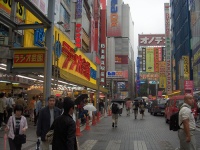 Tokyo OverviewAs a modern city Tokyo, the capital of Japan, could be described
as too good to be true. People dress in the latest gear, excellent
restaurants serve up delicious food of all varieties, and the
trendiest nightclubs keep things hopping. The public transport
system is punctual and one of the most efficient in the world; and
shops and vending machines provide necessities and luxuries both
day and night. All this is achieved in a city that is home to 12
million people, amid the confusion of bumper-to-bumper traffic,
flickering neon signs and a crush of humanity packing subways and
sidewalks. In the crush and rush Tokyo remains, remarkably, one of
the world's safest cities with a low crime rate and local people
who are only too willing to spare the time and effort to assist a
stranger. With such a dense population, Tokyo is an urban maze of
buildings that jostle for space in an unplanned jumble of grey
concrete, which makes parts of it ugly and drab. The city fills a
huge area that seems to go on forever, with no specific city
centre, but rather a succession of districts grouped together. In
the back streets, where timber houses line narrow lanes, there are
reminders that this is exotic Japan: kimono-clad women prune bonsai
trees and colourful neighbourhood festivals take place. The city is an exuberant experience for visitors. It also hosts
many museums and is the largest repository of Japanese art in the
world. Then, of course, it would take forever to exhaust the
shopping possibilities in this megalopolis. The more one explores
Tokyo the more it becomes obvious that one cannot judge a book by
its cover. Inside the modern buildings the cultural life of Japan
is very much alive and well. Interiors reflect the tranquil
minimalist Asian style and taste of Japan. |